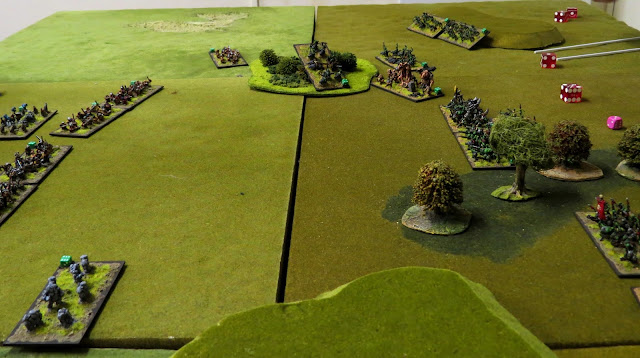This week our usual roleplaying session was interrupted by an unexpectedly absent GM, so I gave some friends a run out with my Warband display armies instead. They've played before, mid-last year so we were all looking forwards to another bash.
Because the armies are designed as showcases, they are a bit of a mixed bag and the lists are as follows:
Goblins
General (Exceptional)
Shaman (Good)
2x Warriors
2x Archers
2x Wolf riders (Skirmish, 1x Hero)
1x Giants
Hill dwarves
General (good)
Spell-smith (average)
2x Warriors (Resolute, Shieldwall)
2x Archers (Shieldwall)
1x Berserkers
1x Boulder elementals
I set up a fixed terrain board, eschewing the terrain placement rules, and the two rival generals set up their forces ready to fight.
This helped save a bit of time, but mainly I just found some nice lightweight boards while I was pootling about at the club.
This helped save a bit of time, but mainly I just found some nice lightweight boards while I was pootling about at the club.
The goblin king anchored his northern flank with his trusty (or perhaps mistrusted) shaman, put his main strength including the giants in the centre, and his archers on the hill to his southern flank.
The canny dwarf king set up behind his infantry centre with his spell-smith. To the north he placed his boulder elementals who he intended to send forth to capture the northern hill. To the south his unruly berserkers bit their axe-hafts and screamed blue murder at the encroaching goblin horde. No quarter would be given and they were ready to sell their lives dearly.
The dwarves opened proceedings with a cautious advance in the centre. However, to the south the berserkers were having none of it. They ignored their king and stomped off as fast as their stumpy legs would carry them. They smelled goblin blood and lost their collective minds...
As an impartial observer I felt the hill dwarves had a better deployment. the Goblins were strung out wide, and their magic user seemed a little out of place on the flank. The opening moves saw the dwarves fail a lot of Motivation tests, including losing control of their berserkers.
The goblins countered by advancing their giants and wolf riders through the southern woodland.
Their natural toughness did the berserkers proud and with their hero point they were able to hold up four goblin units for most of the game. Unfortunately, the rest of the hill dwarf army didn't really exploit the opportunities this created.
Meanwhile, to the north, the goblin shaman and his coterie found themselves in a rather one-sided battle with the horrifying boulder elementals.
The goblin mages did their best with some magic attacks as the boulder elementals closed the distance. The Hill dwarves made a good choice here dumping command points into getting the elementals to charge forwards quickly to prevent taking too much of this spell damage. Once they got into melee with the shamans, there really was only one result, as the goblin king was too far away to help out. After they routed though, the hill dwarf king was focussed elsewhere and so couldn't exert his influence to get the elelmentals back into the fight quick enough.
It was a predictably one-sided fight and in short order the goblin spell casters were fleeing for their lives, never to return.
With the northern flank lost, and the southern flank bogged down, the goblin king throws his centre forwards into the glinting iron wall that is the hill dwarf infantry.
This really was a grind. Resolute shieldwall dwarf warriors are some of the toughest units in the game and the goblins needed all the inspiration their king could muster! They poured command points into their fighting try try and bust through the dwarf armour, but really this was a massive tarpit that even the giants couldn't help break. Those units that did fall back or rout on both sides were swept up by both skilled generals rallying the units that broke free of the front line.
And then, after a bitter and extended fight the hill dwarf berserkers are finally cut down, break and run off by the wolf riders. The goblin southern flank swarms forwards, turning in on the hill dwarf centre.
This was a turning point of sorts. The goblins could now bring in the extra numbers they had tied up on the south flank. that said, while the giants and wolf riders made an impact, the archers just couldn't make the moves quickly enough. Once again the hill dwarves natural toughness proved a hard nut to crack.
The battle here descended into a grind, with both sides having units break and then rallied back into the fight. Finally the hill dwarf king throws himself into the front line in an attempt to try and break the deadlock.
While the dwarves are utterly tough, they're only average in dealing damage and crucially lack the mobility to run down the enemies they rout. This means the opponent often has plenty of time to bring broken units back into the fight! To try and break the deadlock the dwarf king stepped in personally. As the clock ran down though it was too little too late.
Time ran out and both sides had lost about 160pts of troops. The goblins took the battle by about 10 points though so it was little more than a bitter draw. The goblin king claimed victory though!
A good time was had by all and the players certainly seemed to enjoy themselves in what was a hard fought and evenly matched grinding fight. throughout most of the game it really could have gone either way.





















































